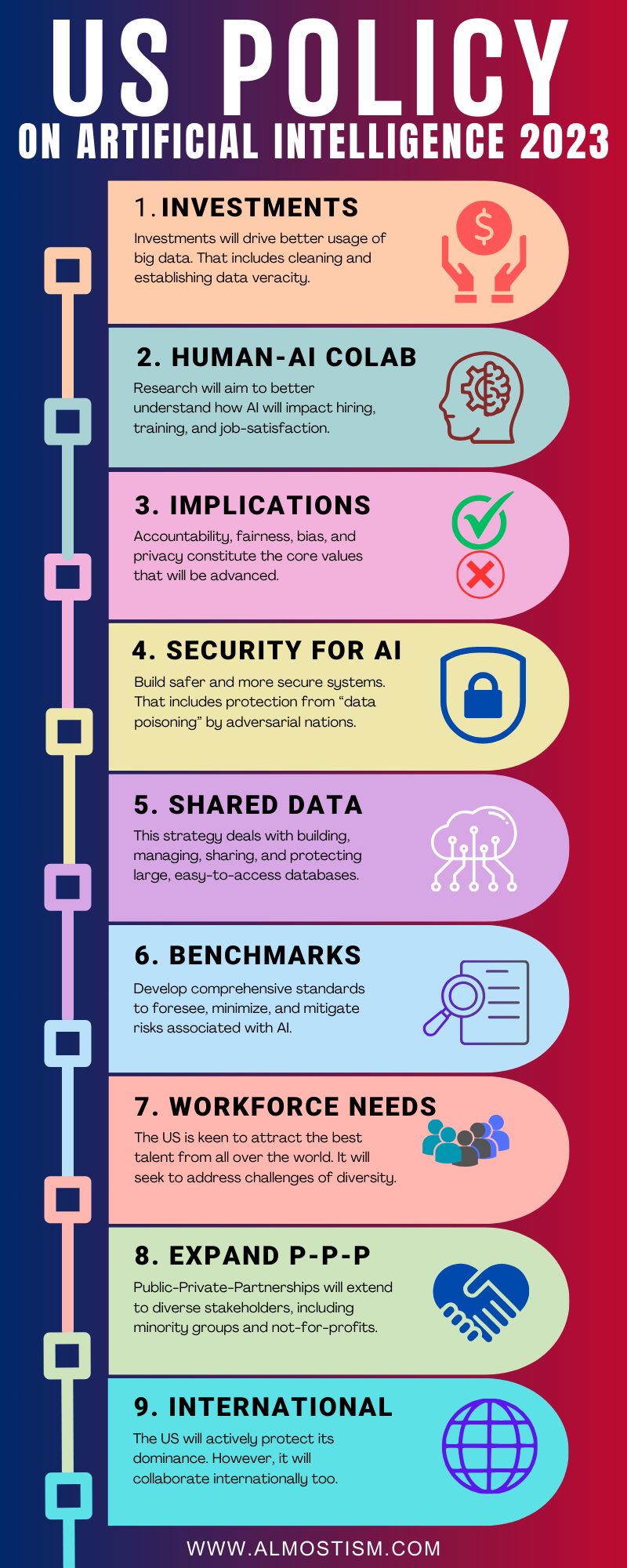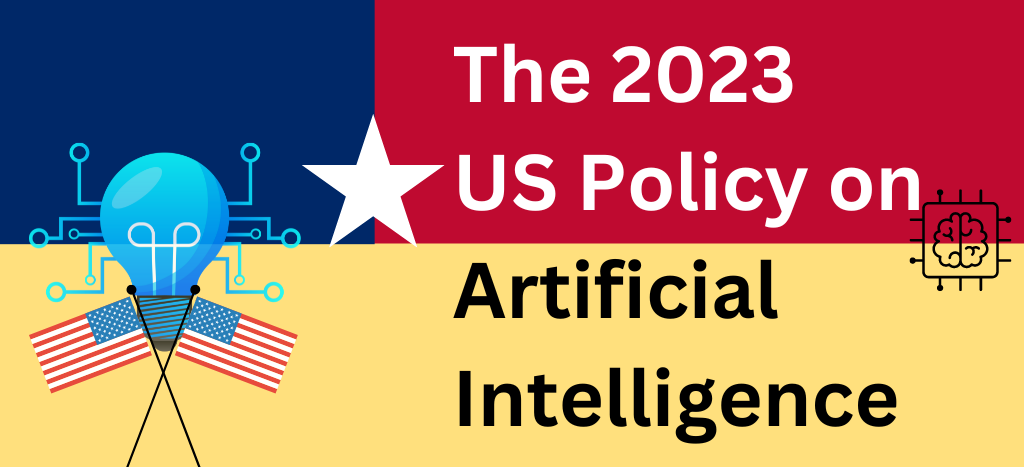The 2023 Update on The National Artificial Intelligence R&D Strategic Plan by the US government provides some insights on how the government will shape its policy to regulate and leverage AI.
Prepared by the Select Committee On Artificial Intelligence of The National Science And Technology Council, the report is key to understanding how the US plans “to sustain and enhance the scientific, technological, and economic leadership position of the United States in AI.”
Given the fact that the AI technology landscape grows at a non-linear pace, authorities worldwide are struggling. And there is the fact that there has never been anything quite like AI in the history of humankind.Now you’ll see why no two governments can quite see it the same way.
Different nations and regions have been working hard on formulating a clear, executable strategy for artificial intelligence. Among these, the strategies in the USA, the UK, the European Union, China, India and Japan are perhaps better documented than others.
Of course, political, technological, and economic considerations significantly impact how AI policies are formulated and made public.
For instance, China’s Social Credit System used facial recognition to achieve results. In doing so, it put aside what elsewhere could have constituted a breach of privacy. Or consider China’s three-year AI action plan. It was kicked off around 2017 can now be better understood in hindsight.
The current article takes a broad view of the US policy on artificial intelligence. In upcoming articles, we shall look at the AI policies of other major economies.
Artificial Intelligence: A very brief history
John McCarthy came up with the term ‘artificial intelligence’ in 1956. There were, however, several earlier studies and efforts to understand if machines could ‘think’. These efforts were not theoretical exercises, but translated to actual projects with long time-lines backed by enormous funding.
After the brief enthusiasm, many people came to a conclusion that the capabilities of AI were greatly overestimated. What followed was coined the ‘AI winter’.
That’s the period where projects pursuing breakthroughs in artificial intelligence were renamed to mask their real objectives. This period lasted from the mid seventies to approximately 1980. (Some consider the period from the late eighties upto the early nineties as the second winter of AI.)
In 1997, Deep Blue beat the reigning World Chess Champion Gary Kasparov. This convinced people that AI was onto something serious. There was a clear feeling it wouldn’t take long before we had intelligent machines.
In 2011, IBM Watson won quiz shows and solved complex riddles. This provided some emphatic evidence that AI was indeed making strides. Substantial wins recorded by chatbots by the end of the 2010’s solidified this perception.
Then ChatGPT happened. And things were never quite the same again.
AI policy in the US: A quick overview of the 2016 and 2019 plans
The US government has taken various initiatives to codify an AI policy. However, the world saw the US government’s approach to AI as more of a hands-off, laissez-faire style. However, things crystallized better, starting with the 2016 document.
The 2016 AI Policy document
In May 20216, a new National Science and Technology Council (NSTC) subcommittee was announced. This subcommittee focused its attention exclusively on ML (machine learning) and AI. Subsequently, in June 2016 a task force was formed.
This task force outlined the federal government’s priorities for and stand on AI. There was a strategic focus on research and development. Areas that the industry at large was not keen to address were placed in the hands of the task force.
The 2016 National Artificial Intelligence R&D Strategic Plan laid out seven strategies. It’s important to note that these were specifically for federally-funded research on artificial intelligence.
Two of these seven strategies were particularly noteworthy.
They were:
1. ‘Develop shared public datasets and environments for AI training and testing’ and,
2. ‘Measure and evaluate AI technologies through standards and benchmarks’.
The next document expanded the list of these strategies.
The 2019 AI Policy document
Before formulating the 2019 document, various initiatives were taken to understand the government and private response to the earlier document. While the suggestions were rich and varied, one thing was clear: none of the original seven strategies were found redundant.
However, a new strategy was added to the existing list of strategies. This strategy was to ‘Expand public-private partnerships to accelerate advances in AI’.
As the potential capabilities of AI started becoming clearer, a greater emphasis was required on evaluating implications. That means addressing the ethical, legal, and societal implications of AI. The National Artificial Intelligence R&D Strategic Plan: 2019 Update took cognizance of this and placed greater emphasis on achieving positive results with AI.
The 2019 plan pointed out the importance to protect the R&D efforts by the American stakeholders from the dangers posed by ‘strategic competitors and adversarial nations’.
The National Artificial Intelligence Research And Development Strategic Plan 2023 Update
Over 60 responses submitted by individuals, research organizations, and other bodies shaped the 2023 plan update. For some reasons, the link to these responses is currently broken (404).
Continuing the tradition of the 2019 plan, the 2023 update did not overturn or eliminate any of the earlier strategies, but added one more strategy. It was about international collaboration (‘Establish a principled and coordinated approach to international collaboration in AI research.’)
If you revisit the earlier strategies, you’ll see the phrase ‘international collaboration’ is conspicuous by its absence. The addition of this strategy could be an indicator of how the US is willing to revisit its stand in the new world order.
Against that, the policy also immediately underlines the self-interest of US policy-makers. On page 8 of the document, right below the list of strategies, it says: ‘The federal government plays a critical role in ensuring that technologies like AI are developed responsibly, and to serve the American people.’
Highlights of the 2023 update
These seven strategies were based around:
1. Long-term investments
The emphasis lies on not only leveraging big data, but establishing veracity and cleaning big data. Investments also seek to created federated computing, where data on each device contributes to a shared global dataset.
2. Human-AI collaboration
The strategy aims at building trust in the human-AI collaboration. In particular, research will aim to understand how AI will impact skill retention, training requirements, and job satisfaction.
3. Ethical and societal implications of AI
This strategy is concerned with “advancing core values”. The thrust will be create metrics that will cover accountability, bias, privacy, and fairness.
4. Security of AI systems
Increased use of AI can put systems to risk of abuse. This strategy of the US government for AI aims to build safer AI. This includes protection from “data poisoning” by adversarial entities.
5. Sharing of datasets
AI is capable of solving challenges across a spectrum of disciplines. To meet such goals, the US government will endevour to build, manage, and secure data sets that can be shared accessed securely and reliably.
6. Measurements standards
In order to further promote R&D, it’s important for the entire AI community to establish benchmarks and standards. A comprehensive set of such standards will evaluate, manage, foresee, minimize, and mitigate risks without strangling breakthroughs.
7. Understanding workforce needs
This is going to be huge. That’s because you’ll not only need to understand and motivate a new kind of workforce but also knit together interdisciplinary experts.
The US is, in particular, keen to attract the best workforce from the world over. The challenge – and the strategy document confesses – is to ensure the extremely diverse workforce works as a whole.
8. Expand P-P-P
The Public-Private-Partnership aims to get the best of both the worlds. It’s that without the Government-University-Industry triad working efficiently, the US will soon lose its dominant position in artificial intelligence.
This strategy also seeks to expand the partnerships to “more diverse stakeholders”. Such stakeholders include minority-supporting bodies, civil society organizations, and not-for-profits, among others.
9. Principled, collaborative approach across international boundaries
As mentioned, this is a new addition. The US is aiming to partner different countries – without sacrificing its own dominant position, of course. Beyond industry and government partnerships, the US will also leverage Embassy Science Fellows Program, U.S. Science Envoy Program, and the Fulbright Program among others.
Here’s an infographic that summarizes the US government’s 9 strategies outlines in the 2023 Update on The National Artificial Intelligence R&D Strategic Plan.

Questions not answered by the 2023 update
- The policy commits itself to testing and sharing information. However, there is no overarching policy that can work like a watchdog.
- Federal as well as state governments are taking a self-regulatory approach. That means the industry or the organization will have to evolve their own code of conduct.
- Nascent technologies need a clear regulatory framework from the start. In absence of clear guardrails, there is are significant risks in safety, ethical practices, and monopolistic positions.
- On 30 October 2023, the Presidential Executive Order announced some plans to mitigate some of the risks with AI technology. Some experts believe this plan might cover some loopholes left open by the 2023 policy update. Effectively, this reduces the original laissez-faire approach of the government. The question is: Is this enough for a country that’s at the forefront of artificial intelligence?
- Federal agencies will keep away from any activities that interfere with the goals of sustaining the US’s leadership position in AI.
Concluding remarks
The US authorities have always stood apart from interfering too much with any industry. Whether it’s the controversial gun lobby, recreational drugs or even outsourcing of jobs, the US government has always let industry take its own path.
Historically, it has helped US businesses prosper and branch out to different countries (from Pizza Hut to GM). However, with the risk that AI poses, this approach could be dangerous for the US in particular and the world in general.
As governments elsewhere are waking up to this fact, we’ll soon see what the US authorities come up with next with artificial intelligence.
